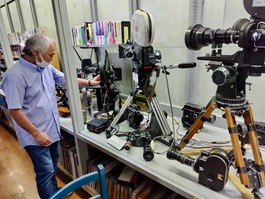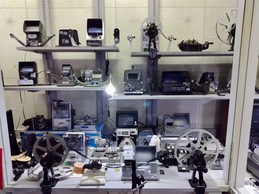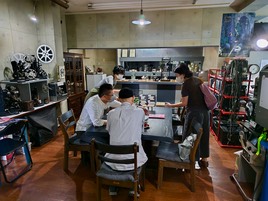
When Markus Nornes and I published the Research Guide to Japanese Film Studies in 2009 (a Japanese translation came out in 2016), we tried to offer in one section a comprehensive guide to facilities for pursing research on film in Japan. A good number of them we regularly utilized, and thus offered our hands-on experience with how to use them, while others we researched by visiting or through other means. As with any synchronic record of the state of a field, a list of such facilities can soon begin to age, as institutions change, appear, or disappear. Some of the places we described sadly no longer exist, but thankfully new institutions have been founded as well. The possibility of a new edition of the Research Guide is very much on our mind, so we regularly visit new places when we can. I sometimes write about them on this blog, such as when I introduced the Ichikawa Kon Memorial Room a while back.

So when I visited Hokkaido this summer, I made a point of scouting out the Sapporo Film and Video Equipment Museum (that's my translation of 札幌映像機材博物館). Originally created in Noboribetsu by a former film cameraman, Yamamoto Bin, it moved to Sapporo last year into a nondescript building in a nondescript section of town in the Shiroishi neighborhood. Not all of it is organized but I tend to agree with the museum head that there is really nothing like this in all of Japan. There are just hundreds of examples of film and video equipment, from cameras, film viewers, editing machines (Steenbecks, etc.), and projectors, to sound recorders, video cameras, and editing decks. There are so many 8mm cameras they are literally in a pile. One of the largest items is a Panther crane. Many of the main items have display descriptions (though in Japanese) to help the visitor understand their significance.

Most of the equipment is postwar, but the museum has some prewar cameras and projectors, including a range of Pathé Baby equipment. Many of the machines still work, since Yamamoto repairs and sometimes jerry rigs them (adding an electrical motor to some old projectors, for instance). A good number of the machines on display can thus be handled and used. Especially those raised on digital projection can obtain a different sense of the cinema when they can hand crank a silent era 35mm projector and actually see what is projected.

There are other institutions that have film equipment on display. The National Film Archive has some in its permanent exhibit, including famously Ofuji Noburo’s animation stand, but no where near this number and only the dramatic stuff—not the dry but still essential items like film viewers and editing equipment. It also doesn’t let you handle them. The Toy Film Museum in Kyoto has many home projectors on display, including a good number you can operate, but its collection does not extend to professional or video equipment. Finally, the Extinct Media Museum in Otemachi in Tokyo also features a hands on display of film cameras and projectors—as well as examples of other personal media devices from digital cameras to cell phones (the latter in their Koenji branch)—but it also has a limited number of machines on display and does not include professional equipment. The Sapporo Film and Video Equipment Museum is thus truly unique.

The Museum does have books and film prints, too, although most are not yet catalogued. The prints are mostly 16mm films obtained from defunct local lending libraries and center on films related to Hokkaido. The museum is free, and has a small cafe if you want a cup of coffee while fiddling with your favorite Elmo. It also occasionally holds events like small concerts. Yamamoto-san will also repair your camera or projector for a fee, and also sells frames from old film trailers. But there is no public funding for this institution. It is truly a privately run facility, a labor of love by an old film hand. Yamamoto is hoping on crowdfunding to help maintain the place.
So if you are near Sapporo, definitely give this place a try.

